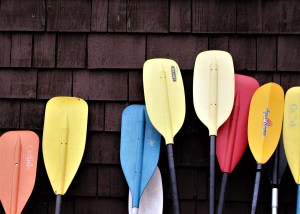Is Rafting safe?
Bow river rafting is a fun outdoor experience that can be had by all. Like with any outdoor excursion, white water rafters can experience a certain amount of risk. This risk, however, is often a calculated decision that many rafters choose to ignore.
It is best to understand what risks await on the river, in order for your experience to be a safe and fun one. Learn more about the potential dangers of white water rafting and how to stay safe on the river.

Dangers of white water rafting
The first danger that many first-time rafters think of is drowning. Although a valid concern, the overall risk of drowning is low, especially if rafters adhere to all safety guidelines. You don’t have to be a good swimmer, either. Since rafters are required to wear floatation devices, this helps mitigate the risk of drowning instances. The real risk of drowning occurs when the water is too high or because of deceptive flow strength.
If you were to lose your footing in a strong flow area, you could easily be pulled under. Capsizing is also a risk while rafting, which could cause you some serious damage. Injuries can occur from smashing against sharp rocks or boulders while out of the boat. If you do get thrown out of the boat, try to remain calm and follow safety procedures.
How to stay safe while white water rafting
There are several ways you can decrease the chance of danger while white water rafting. Follow along with these quick tips so you can have a fun and safe rafting adventure.
Wear the right safety gear.
Safety gear is there for a reason. Life jackets are known to save lives in dangerous rafting situations. Be sure you are wearing your life jacket correctly so that you can take advantage of this simple safety measure. Be sure all the clips are fastened and the jacket fits your body well. Have a friend put their fingers under the shoulder area and tug gently upward to check that it won’t go over your head. Your guide will also help fit your jacket correctly before you depart.
Wearing a helmet can also help save your life in case of emergency. Helmets help prevent head trauma if the boat were to flip or if you get swept downriver. Clip the helmet securely under your chin and keep it on for the duration of your rafting trip.
Wear the right clothing.
Wearing comfortable, protective clothing can also help keep you safe on the river. Always wear well-fitting water shoes or sandals, preferably ones that cover your toes. A long-sleeve, moisture-wicking shirt can also help keep your skin safe from sunburn or insect bites. You can also bring a pair of UV protective eyewear or a wide-brimmed hat to cover up from the sun’s rays.
Go with a pro.
When white water rafting, always go with a professional outfitter. Going with a professional guide is the best way to stay safe on the river. Your guide will prep your crew with safety instructions prior to launch and is trained to handle emergency situations.
For more information on river rafting safety, contact Lazy Day Raft Rentals.
